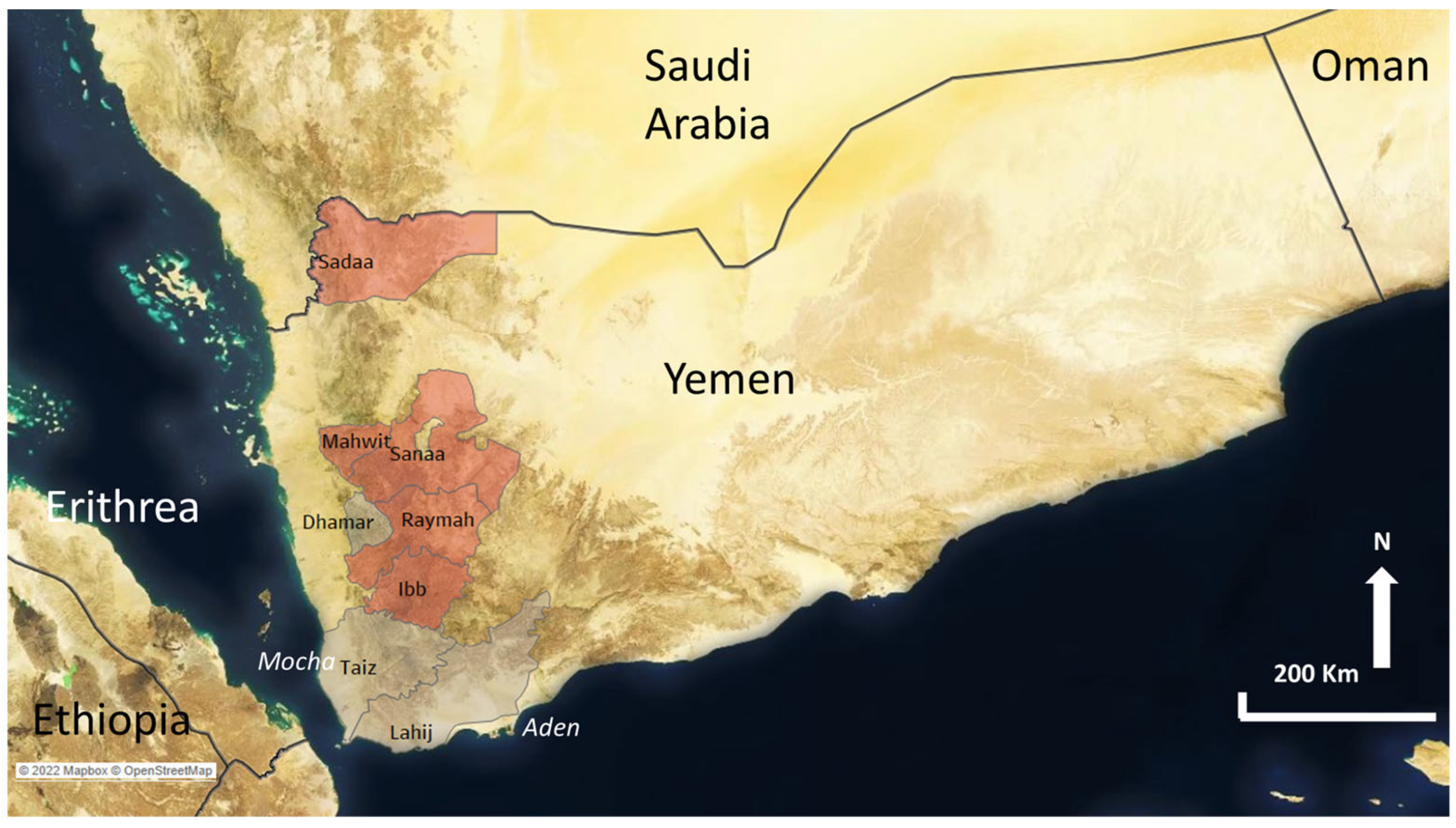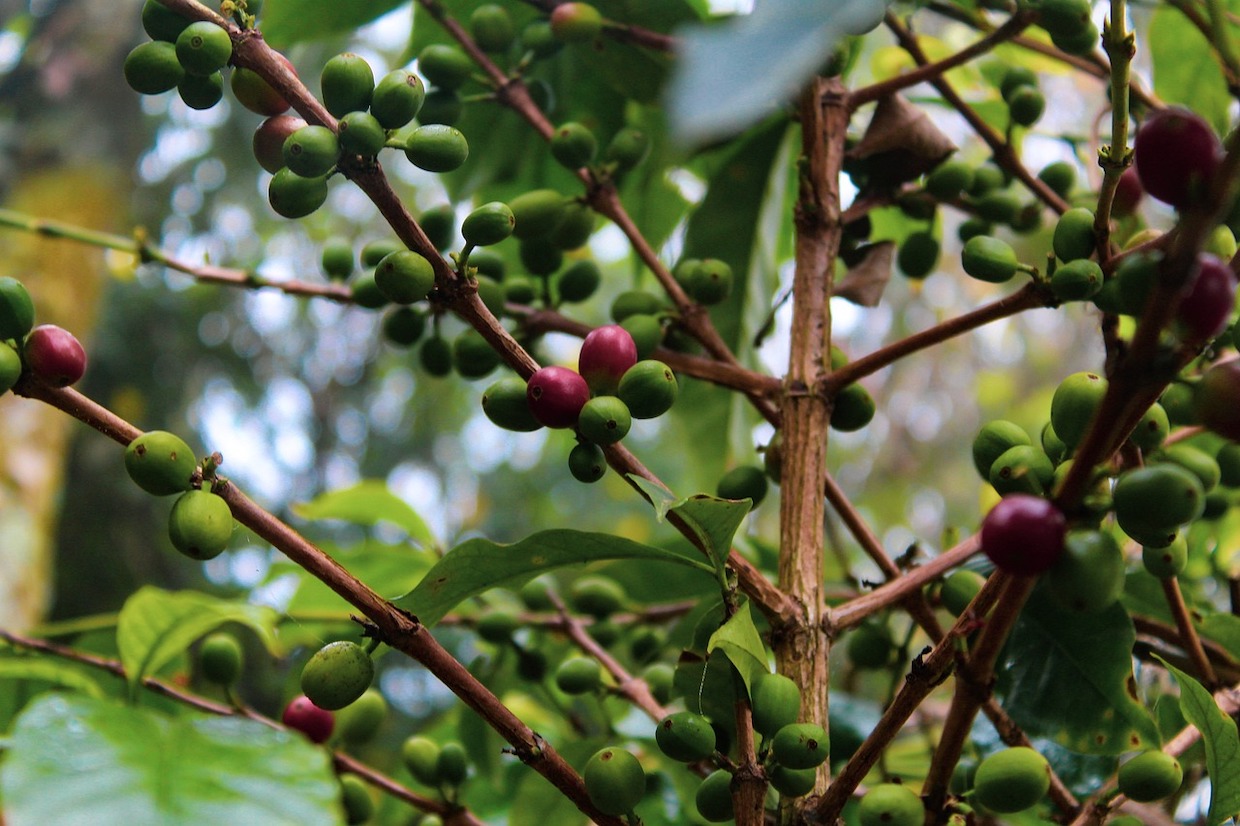DNA fingerprinting technology has been employed to flesh out the origin story of coffee itself.
In a groundbreaking study published last month, researchers shed new light on the early movements of the arabica coffee species that took place centuries ago, pinpointing genetic clusters and domestication routes in commercial coffee’s infancy.
While Ethiopia is firmly established as the genetic birthplace of coffee, Yemen has long been considered something of a bassinet, a first cradle through which coffee further genetically evolved and eventually made its way to the rest of the world.
The new research — led by France-based Christophe Montagnon of RD2 Vision — involved the genetic fingerprinting of 555 different strains of arabica across Ethiopia, Yemen and elsewhere in the world. The authors describe it as the “first study to cover the entire genetic diversity of both Ethiopia and Yemen.”

Geographical origin of Ethiopian coffee samples included in the study. Samples originate from several Woreda (districts) located in three regions: Southwest, south and east. Southwest and south regions correspond to the natural habitat of C. arabica in Ethiopia. Open-access image from Agronomy: https://doi.org/10.3390/agronomy12123203
A major piece of good news from the study was that there appeared to be no loss of genetic diversity among cultivated arabica — as opposed to wild arabica — since groundbreaking research more than a half century ago.
“While legitimate concerns have been raised on the impact of deforestation and climate change on the erosion of the genetic diversity of C. arabica in Ethiopia, our study did not detect such genetic diversity loss for cultivated coffee,” the authors wrote.
Making the study possible was the participation of a multinational group of stakeholders with different interests. Author affiliations are linked to R2D (France), Yemen-focused coffee company Qima Coffee (UK and Yemen), the nonprofit Alliance for Coffee Excellence (United States), the Ethiopian Coffee and Tea Authority and the Ethiopian Institute for Agricultural Research.
Funding for the study was provided by Qima Coffee, for the Yemeni samples, and by the USAID Ethiopia Feed the Future Value Chain Activity.
“Beyond the fascinating results, a critical part of this study’s grand achievement is the fact that it brought together two of the world’s most important and historic coffee origins in a pioneering research project to create knowledge for the benefit of farmers,” Faris Sheibani, CEO and Founder of Qima Coffee, said in an announcement of the publication. “That alone is something worth celebrating.”
The genetics research resulted in the identification of six main genetic mother populations. All of the world’s current cultivated coffee can be traced back to at least one of these groups.
The researchers identified them as: Core Ethiopia 1, Core Ethiopia 2, Ethiopian Legacy, Typica-Bourbon, New-Yemen and Harrar.

Geographical origin of Yemeni coffee samples included in the study. Open-access image from Agronomy: https://doi.org/10.3390/agronomy12123203
The Ethiopian Legacy genetic group, descended from the Ethiopia Core 1 and 2 groups, was found in Southern Ethiopia and in Southern Yemen, making it the link between the two geographic locations.
From the Ethiopian Legacy group in Yemen came two of the other core groups: Typica-Bourbon and New Yemen. The latter group, which never left Yemen, was first identified in a study by RD2 and Qima Coffee in 2020.
The final core domesticated genetic group, dubbed by researchers as Harrar, was traced to the Eastern Ethiopian region of Hararghe after originating in either Yemen or Ethiopia.
While codifying the early history of domesticated coffee through the centuries, the research also points to the future.
Wrote the authors, “Our study also proposes new leads for the exploitation of hybrid vigor through crosses between genetically distant parents.”
The complete study was published last month in Agronomy, one of hundreds of titles maintained by the open-access publishing platform MDPI.
Does your coffee business have news to share? Let DCN’s editors know here.
Nick Brown
Nick Brown is the editor of Daily Coffee News by Roast Magazine.
Comment
1 Comment
Comments are closed.







I am working in Ethiopian coffee and tea authority, I have effect of climate change …proposal wishing a supportive project
Proposal on
Mitigation of the effect of climate change on coffee development in Ethiopia
In Ethiopia climate change factors immerging as challenges in production of coffee. Among these are:-
Lack of awareness on the effect of climate change (as rainfall onset/stops early or late) on coffee development
• Coffee seed preparation, coffee nursery management, coffee maintenance activities, post harvest activities, etc input supply operations are not performed as scheduled normal since the climate changing
Prolonged rainy/dry seasons
• Abnormal growth of vegetation, unexpected diseases/pests occurrence, etc
Continuous rainfall and other climatic features fluctuations and
No use of meteorological data as input for coffee development.
A. Main climate change problems observed in coffee development
1. Lack of awareness on the effect of climate change (prolonged rainfall season, prolonged dry season, etc ) on coffee development
Coffee flowering time, flower amount, flower abortion rate, etc
Coffee seed preparation time, coffee nursery management, coffee farm management, coffee post harvest technology operations, etc
2. Prolonged rainy season
Stress less coffee tree and lack of coffee product
Unmanageable coffee flower
Fast growth of weeds, vegetation, etc
Occurrence of usual/unusual coffee diseases/pests
• Occurrence of coffee major diseases/pests
• Occurrence of coffee minor diseases/pests as major
• Difficulty in protection/control of coffee diseases/pests because of the prolonged rain
3. Prolonged dry season
Long coffee stress period and excess coffee production
Weak growth of weeds, vegetation, etc
Occurrence of usual/unusual coffee diseases/pests
• Occurrence of coffee major diseases/pests
• Occurrence of coffee minor diseases/pests as major
• Difficulty in protection/control of coffee diseases/pests because of the dry season
4. Rainfall and other climatic features fluctuations
• Rainfall season/date (rainfall onset of time)
• Rainfall time (starting and stopping)
• Rainfall intensity, etc
5. No enough methodological data collecting sites or weak use of methodological data for important coffee development
B. Mitigation measures for the climate change problems
6. Giving training to experts from federal to technically selected weredas and supervision
6.1 training on the effect of climate change (prolonged rain or dry season, etc) on coffee flower, coffee seed preparation, coffee nursery management and coffee post harvest technology is given to the addressed experts
6.2 detail training coffee production operations to be performed are cross checked by supervision and experience sharing
7. Assessment survey on climate change is carried out
7.1 presence or absence of prolonged rainfall, rainfall amount fluctuation, rainfall onset time, rainfall starting time, rainfall stopping time, etc are recorded
7.2 presence or absence of prolonged dry season are recorded rainfall amount fluctuation, rainfall onset time, rainfall starting time, rainfall stopping time, are etc recorded
7.3 coffee flowering time, coffee flower amount, coffee flower abortion rate, coffee flower round, also recorded
7.4 presence or absence of meteorological data collection site record, other interrelated information are collected to use them inputs for the project work
8. Plan to implement climate change mitigating measures
8.1 Recording Rainfall starting and stopping time, date, intensity, flower time, flower round, flower amount data, etc and using them input for the coffee production
8.2 Practicing modern coffee production system in coffee farm
8.2.1 modern coffee seedling preparation systems
8.2.2 modern young coffee maintenance systems
8.2.3 modern matured coffee maintenance systems
8.2.4 modern post harvest and quality improvement systems
8.3 Performing proper coffee diseases and pests protection/control measures
9. Establishment and follow up of coffee development demonstration sites
9.1 coffee nursery sites
9.2 coffee development farm (young or matured) sites
9.3 coffee post harvest technology sites
9.4 monthly, quarterly and yearly report evaluations
10. Establishment of pilot meteorological data collecting sites and using data as input for coffee development
10.1 Giving training to experts
10.2 Collecting, exchanging and analyzing data, using it input for coffee development
11. Establishment meteorological data analysis system soft ware and using it for the coffee production (disease and pest analysis, weed control system, etc)
12. Continuous follow up and supervision of all above operations